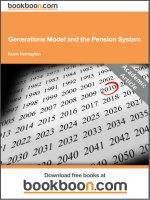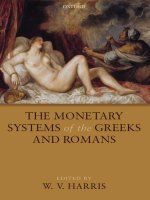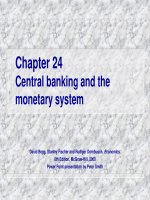central banking and the monetary system
Bạn đang xem bản rút gọn của tài liệu. Xem và tải ngay bản đầy đủ của tài liệu tại đây (156.75 KB, 14 trang )
Chapter 24
Central banking and the
monetary system
David Begg, Stanley Fischer and Rudiger Dornbusch, Economics,
6th Edition, McGraw-Hill, 2000
Power Point presentation by Peter Smith
24.1
The central bank
acts as banker to the commercial
banks in a country
and is responsible for setting interest
rates.
In the UK, the Bank of England fulfils
these roles.
Two key tasks:
– to issue coins and bank-notes
– to act as banker to the banking system
and the government.
24.2
The Bank and the money supply
Three ways in which the central bank MAY
influence money supply:
– Reserve requirements
central bank sets a minimum ratio of cash reserves
to deposits that commercial banks must meet
– Discount rate
the interest rate that the central bank charges when
the commercial banks want to borrow
setting this at a penalty rate may encourage
commercial banks to hold more excess reserves
– Open market operations
actions to alter the monetary base by buying or
selling financial securities in the open market
24.3
The repo market
A gilt repo is a sale and repurchase
agreement
– e.g. a bank sells you a gilt with a simultaneous
agreement to buy it back at a specified price at
a specified future date.
– this uses the outstanding stock of long-term
assets (gilts) as backing for new short-term
loans
Used by the Bank of England in carrying
out open market operations
24.4
Other functions of the Bank of England
Lender of last resort
– the Bank stands ready to lend to banks and
other financial institutions when financial
panic threatens
Banker to the government
– the Bank ensures that the government can
meet its payments when running a budget
deficit
Setting monetary policy to control
inflation
– more of this later
24.5
The demand for money
The opportunity cost of holding
money is the interest given up by
holding money rather than bonds.
People will only hold money if there
is a benefit to offset that opportunity
cost.
24.6
Motives for holding money
Transactions
– payments and receipts are not perfectly
synchronized:
so money is held to finance known transactions
depends upon income and payment arrangements
Precautionary
– because of uncertainty:
people hold money to meet unforeseen
contingencies
depends upon the (nominal) interest rate
24.7
Motives for holding money (2)
Asset
– people dislike risk
– so may hold money as a low-risk component
of a mixed portfolio
depends upon opportunity cost (the nominal interest
rate)
Speculative
– people may hold money rather than bonds
– if bond prices are expected to fall
– i.e. the interest rate is expected to rise
depends upon the rate of interest and on
expectations about bond prices
24.8
The demand for money: summary
The demand for money is a demand
for real money balances
It depends upon:
– real income
– nominal interest rate (the opportunity
cost of holding money)
– the price level (currently assumed fixed)
– expectations about future interest rates
24.9
Money market equilibrium
Real money holdings
LL
Other things being equal,
the demand for real money
balances will be lower when
the opportunity cost (the rate
of interest) is relatively high.
The position of this
schedule depends upon
real income and the price
level.
When money supply is L
0
, money market equilibrium
occurs when the rate of interest is at r
0
.
L
0
r
0
24.10
Reaching money market equilibrium
Real money holdings
LL
L
0
r
0
If the rate of interest is
set below the market
equilibrium – say at r
1
r
1
there is excess demand for
money (the distance AB)
A B
This implies an excess
supply of bonds
– which reduces the price
of bonds
and thus raises the rate of interest until equilibrium
is reached.
24.11
Monetary control
Real money holdings
LL
L
0
r
0
Given the money demand schedule:
The central bank can
EITHER set the interest
rate at r
0
and allow money
supply to adjust to L
0
OR set money supply at L
0
and allow the market rate
of interest adjust to r
0
BUT cannot set both
money supply and interest
rate independently.
24.12
Monetary control – some provisos
Monetary control cannot be precise unless
the authorities know the shape and
position of money demand
Controlling money supply is especially
problematic
– and the Bank of England has preferred to work
via interest rates
The situation is further complicated by the
relationship between the interest rate and
the exchange rate
24.13
Targets and instruments of
monetary policy
Monetary instrument:
– the variable over which the central bank
exercises day to day control
– e.g. interest rate
Intermediate target
– the key indicator used as an input to frequent
decisions about when to set interest rates
The financial revolution has reduced the
reliability of money supply as an indicator
– and central banks increasingly use inflation
forecasts as the intermediate target









